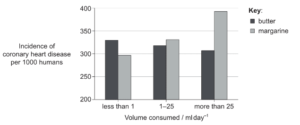1. The Framingham heart study was an observational study that went on for 20 years. The following data were produced.

[Source: adapted from Gillman et al., Margarine intake and subsequent coronary heart disease in men.
Epidemiology, 1997 Mar; 8(2): 144–9]
Which conclusion can be drawn, based on these data?